Western blotting Study guides, Class notes & Summaries
Looking for the best study guides, study notes and summaries about Western blotting? On this page you'll find 72 study documents about Western blotting.
All 72 results
Sort by
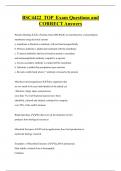
-
BSC4422 TOP Exam Questions and CORRECT Answers
- Exam (elaborations) • 24 pages • 2024
-
- $8.99
- + learn more
Western blotting a. Proteins from SDS-PAGE are transferred to a nitrocellulose membrane using electrical current a. membrane is blocked so antibody will not bind nonspecifically b. Primary antibody is added and incubated with the membrane c. To detect antibodies that have bound to protein a secondary anti-immunoglobulin antibody coupled to a reporter a. Excess secondary antibody is washed off the membrane b. Substrate is added that precipitates upon reaction c. Reveals visible band where...
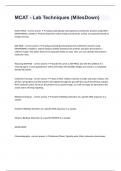
-
MCAT - Lab Techniques (MilesDown) with 100% correct answers
- Exam (elaborations) • 3 pages • 2024
- Available in package deal
-
- $9.99
- + learn more
MCAT - Lab Techniques (MilesDown)Native-PAGE - correct answer A polyacrylamide gel electrophoresis method for proteins using NON-DENATURING conditions. Proteins keep their native charge and structure so they are separated based on charge and size. SDS-PAGE - correct answer A polyacrylamide gel electrophoresis method for proteins using DENATURING conditions. Sodium Dodecyl Sulfate denatures the proteins and gives the proteins a uniform charge. This allows them to be separated solely on mass, t...
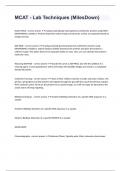
-
MCAT - Lab Techniques (MilesDown) fully solved
- Exam (elaborations) • 3 pages • 2024
- Available in package deal
-
- $9.99
- + learn more
MCAT - Lab Techniques (MilesDown) Native-PAGE - correct answer A polyacrylamide gel electrophoresis method for proteins using NON-DENATURING conditions. Proteins keep their native charge and structure so they are separated based on charge and size. SDS-PAGE - correct answer A polyacrylamide gel electrophoresis method for proteins using DENATURING conditions. Sodium Dodecyl Sulfate denatures the proteins and gives the proteins a uniform charge. This allows them to be separated solely on mass,...

-
AP Bio Genetics, RNA, and DNA Practice Exam 110 Questions with Verified Answers,100% CORRECT
- Exam (elaborations) • 28 pages • 2024
-
- $11.49
- + learn more
AP Bio Genetics, RNA, and DNA Practice Exam 110 Questions with Verified Answers In his transformation experiments, what did Griffith observe? a. Mutant mice were resistant to bacterial infections. b. Mixing a heat-killed pathogenic strain of bacteria with a living nonpathogenic strain can convert some of the living cells into the pathogenic form. c. Mixing a heat-killed nonpathogenic strain of bacteria with a living pathogenic strain makes the pathogenic strain nonpathogenic. d. Infecti...
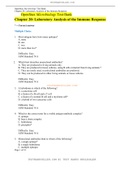
-
OpenStax Microbiology Test Bank Chapter 20: Laboratory Analysis of the Immune Response
- Exam (elaborations) • 18 pages • 2022
-
- $14.49
- 1x sold
- + learn more
OpenStax Microbiology Test Bank Chapter 20: Laboratory Analysis of the Immune Response * = Correct answer Multiple Choice 1. Most antigens have how many epitopes? A. none B. one C. two D. more than two* Difficulty: Easy ASM Standard: N/A 2. Which best describes monoclonal antibodies? A. They are produced in living animals only. B. They are produced in tissue cultures, using B cells extracted from living animals.* C. They are rarely used, so polyclonal antibodies are preferred. ...
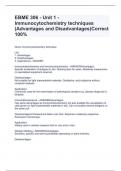
-
EBME 306 - Unit 1 - Immunocytochemistry techniques (Advantages and Disadvantages)Correct 100%
- Exam (elaborations) • 2 pages • 2024
-
Available in package deal
-
- $10.49
- + learn more
Given immunocytochemistry technique List: 1. Advantages 2. Disadvantages 3. Applications - ANSWER Immunohistochemistry and immunocytochemistry - ANSWERAdvantages: Specific localisation of antigens in situ. Staining lasts for years. Relatively inexpensive- no specialised equipment required. Disadvantages: Not suitable for light impenetrable materials. Qualitative, and subjective without computer analysis. Application: Commonly used for the examination of pathological samples e....
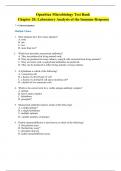
-
OpenStax Microbiology Test Bank Chapter 20: Laboratory Analysis of the Immune Response
- Exam (elaborations) • 13 pages • 2024
- Available in package deal
-
- $14.00
- + learn more
OpenStax Microbiology Test Bank Chapter 20: Laboratory Analysis of the Immune Response * = Correct answer Multiple Choice 1. Most antigens have how many epitopes? A. none B. one C. two D. more than two* 2. Which best describes monoclonal antibodies? A. They are produced in living animals only. B. They are produced in tissue cultures, using B cells extracted from living animals.* C. They are rarely used, so polyclonal antibodies are preferred. D. They can be produced in either liv...
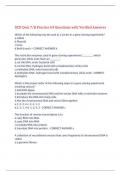
-
GCD Quiz 7/8 Practice 69 Questions with Verified Answers,100% CORRECT
- Exam (elaborations) • 13 pages • 2024
-
- $10.99
- + learn more
GCD Quiz 7/8 Practice 69 Questions with Verified Answers Which of the following may be used as a vector in a gene-cloning experiment? a.mRNA b.Plasmid c.Virus d.Both b and c - CORRECT ANSWER d The restriction enzymes used in gene-cloning experiments _______, which generates sticky ends that can _______. the DNA, enter bacterial cells the DNA, hydrogen bond with complementary sticky ends late DNA, enter bacterial cells late DNA, hydrogen bond with complementary sticky ends - CORRE...
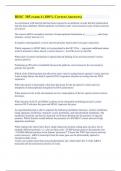
-
BIOC 385 exam 4 (100% Correct Answers)
- Exam (elaborations) • 6 pages • 2023
-
Available in package deal
-
- $11.16
- + learn more
An experiment with bacteria that has been exposed to an antibiotic reveals that the translocation step has been inhibited. Which antibiotic was likely used? correct answers none of these answers are correct. The correct mRNA secondary structure of transcriptional termination is __________ stem-loop structure. correct answers 3-4 In negative autoregulation, correct answers proteins repress their own gene expression. Which sequence is MOST likely to be prenylated in the ER? (The ... repre...
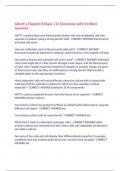
-
Albert's Chapter 8 Exam 115 Questions with Verified Answers,100% CORRECT
- Exam (elaborations) • 12 pages • 2024
-
- $11.49
- + learn more
Albert's Chapter 8 Exam 115 Questions with Verified Answers WITTF: machine that sorts fluorescently labeled cells and nonlabeled cells into separate containers using a strong electric field - CORRECT ANSWER fluorescence-activated cell sorter How are antibodies used to fluorescently label cells? - CORRECT ANSWER fluorescent molecule attached to antibody, which binds to a very specific cell type How does a fluorescent-activated cell sorter work? - CORRECT ANSWER individual cells travel s...

Did you know that on average a seller on Stuvia earns $82 per month selling study resources? Hmm, hint, hint. Discover all about earning on Stuvia


